Biography
Interests
Marta Reis1,2,3*, Lúcia Ramiro1,2, Diego Gomez-Baya4 & Margarida Gaspar de Matos1,2,5
1Aventura Social - Faculdade de Motricidade Humana /Universidade de Lisboa, Portugal
2ISAMB /Faculdade de Medicina da Universidade de Lisboa, Lisboa, Portugal
3Post-doctoral Students of the Foundation for Science and Technology, Portugal
4Departament of Social, Developmental and Educational Psychology, Universidade de Huelva, Huelva, Espanha
5Sabbatical Grant Foundation for Science and Technology, Portugal
*Correspondence to: Dr. Marta Reis, Psychologist of sexual and clinical health, Faculty of Human Kinetics/ University of Lisbon, Portugal.
Copyright © 2018 Dr. Marta Reis, et al. This is an open access article distributed under the Creative Commons Attribution License, which permits unrestricted use, distribution, and reproduction in any medium, provided the original work is properly cited.
Abstract
Universities are important organizations in what concerns the creation and improvement of health and wellbeing, thus healthy universities represent a key application of the health-promoting settings approach. The healthy Universities concept has a strong theoretical basis, and it appears appealing amongst universities worldwide. However, the way in which the approach has been implemented remains poorly grounded in theory. This systematic review aims to describe how universities have implemented the Healthy Universities concept in different cultures. In order to achieve this aim, we analyzed the following aspects of the implementation of the Health Promoting University: (a) definition of Healthy University; (b) priority areas of action; (c) subject matters; (d) projects and coordination; and (e) project evaluation and possible results.
PsycINFO, ISI Web of Knowledge, ISI Proceedings, PubMed, Medline, Lilacs and Scielo were searched for articles on Health Promoting Universities, published between 1997 and 2017. Studies detailing the implementation of a Health Promoting University approach were included.
Fourteen studies were identified for in-depth analysis. Of those, four were theoretical papers, and
ten were intervention studies. The programs described in the selected studies are mostly based on the
guidelines of the Edmonton Charter. They incorporated the main areas of action and subject matters
proposed by the Healthy Universities framework. The implementation of healthy policies and the
incorporation of health promotion in the curriculum remain challenging. The review suggests that
most of the universities work towards similar goals, relying on the Healthy Universities framework,
yet that the way in which initiatives are implemented depends on the context.
Introduction
Universities are important organizations in what concerns the creation and improvement of health and
wellbeing, thus healthy universities represent a key strategy in the health-promoting settings approach [1-3].
As an organization, higher education plays a major role in shaping society, with significant social, economic
and environmental impacts at regional, national and global levels [4,5]. The individuals who constitute
the university community (students, professors, researchers, technicians, etc.) are, or will be, professionals,
politicians and leaders in different areas of society, and may directly influence society with their habits,
beliefs and attitudes [5].
In Portugal there are 116 higher education institutions (HEIs) [6], each a large and diverse community: the extensive workforce within universities comprises 32,580 professors [7] and 361,943 students [8]. Moreover, students attending university may be at a key transition point in their lives - living away from home for the first time and transitioning from childhood to adulthood without the close support of family; or having to balance the competing demands of work and family life with studying and academic practice. University provides the opportunity to explore and experiment with new experiences, build life skills and develop people’s potential. It is also a place where students can clarify their values, develop as global citizens and prepare for their future roles within communities, workplaces and society as a whole [5,9].
Although the settings approach would appear to resonate with higher education values of engagement, diversity, participation and collaboration, the concept of a healthy university has been adopted at a slow speed. At a European level, the Health Promoting Universities framework has been developed over the past decades through milestone events such as the International Conference on Health Promoting Universities held in 1996; the publication of the guidelines for establishing Health Promoting Universities by WHOEuro in 1998; and the Edmonton Charter for Health Promoting Universities of 2006 [10,11].
The framework states the objectives that must be pursued to build a Healthy University and mentions what the expected outcomes should be. The objectives of a Healthy University are: (a) to promote healthy and sustainable policies and planning throughout the university; (b) to provide a healthy working environment; (c) to support the healthy personal and social development of the persons involved; (d) to establish and improve primary health care; (e) to ensure a healthy and sustainable physical environment; (f) to encourage wider academic interest and developments in health promotion; and (g) to develop links with the community [10,12]. The results of a Healthy University program should demonstrate the extent to which health has been integrated in the culture, structure and processes of the university; and the extent to which the health of the members of the university community improved. The implementation of the key objectives may be described in terms of process and impact, rather than outcomes, whereby collaboration and networking are key elements [11,13]. Moreover, universities can also demonstrate improvements in terms of service, academic performance, and providing conditions for good health.
Several universities have assumed this commitment to health, but only a minority has adopted the whole system approach following the Health Promoting Universities concept [2,10-14]. This concept was launched more than two decades ago, and draws on a number of different experiences, including settings- based interventions such as health-promoting schools, workplaces and hospitals, and the expertise of the WHO Healthy Cities Project Office.
The Healthy Universities approach was first promoted in England in the mid-1990s. Since then, initiatives have been developed in other countries in Europe, Asia, and Latin America [15-20]. As countries and cultures differ, the context for implementing the approach also varies widely. Since health promotion interventions are more effective when they are adapted to context [21], Health Promoting University initiatives should be adapted to local culture, environmental context (e.g. rural, urban) and institutional characteristics [22].
Consequently, health-related programs are more effective when they are adapted to the target population, and where university community members are empowered through the implementation process of active participation throughout the program, which is an important additional benefit [23].
However, this implementation of healthy universities, as already mentioned, has been very slow, because there is scarcity of evidence for the effectiveness of the settings approach - both generally and with regard to healthy universities in particular [1,3,24]. Although universities have enormous potential to increase student and community wellbeing, it is a challenge to demonstrate the added value of the whole-system of the healthy universities approach both for health and for the ‘core business’ of higher education.
The Healthy Universities concept has a strong theoretical basis, and it appears appealing amongst universities worldwide. However, the way in which the approach has been implemented remains poorly grounded in practice. This systematic review aims to describe how universities have implemented the Healthy Universities concept in different cultures. In order to achieve this aim, we analyzed the following aspects of the implementation of the Health Promoting University: (a) definition of Healthy University; (b) priority areas of action; (c) subject matters; (d) projects and coordination; and (e) project evaluation and possible results.
Methods
To identify relevant published work on the implementation of the Healthy Universities approach, a search
of PsycINFO, ISI Web of Knowledge, ISI Proceedings, PubMed, Medline, Lilacs and Scielo was performed
in January and February 2018. The search terms used were ‘Healthy University/ies’ OR ‘Health Promoting
University/ies’ in either the title or the abstract. To select relevant publications, the following inclusion criteria
were used: (a) published between 1997 and 2017; (b) full text available in English, Portuguese or Spanish; (c)
explicit reference to higher education or university; (d) focus on the improvement of health and well-being
for the whole university; (e) description of the implementation process of a Health Promoting University
initiative and finally (f) being open access papers. A sequential process of examining the title, abstract and
main text of each article or book (chapter) was undertaken, with exclusion of documents occurring at each
stage. The reference sections of all articles meeting the inclusion criteria, as well as those of previous review
articles, were also searched for further relevant studies, which were in turn acquired and checked against the
inclusion criteria. Studies were excluded when they: (a) did not refer to the process of implementation of
the Health Promoting University approach; or (b) duplication existed or (c) was not considered relevant for
the present work.
Papers that met the inclusion criteria were separated into theoretical papers and intervention studies. The
analysis of theoretical documents was done for each document separately, while that of intervention studies
was done jointly. For both types, the content of the selected articles was analyzed paying attention to the
following: (a) definition of Healthy University; (b) priority areas of action; (c) subject matters; (d) projects
and coordination; and (e) project evaluation and possible results. Information extracted from the articles was
summarized in tables. Data extraction from the selected articles was done by the first author.
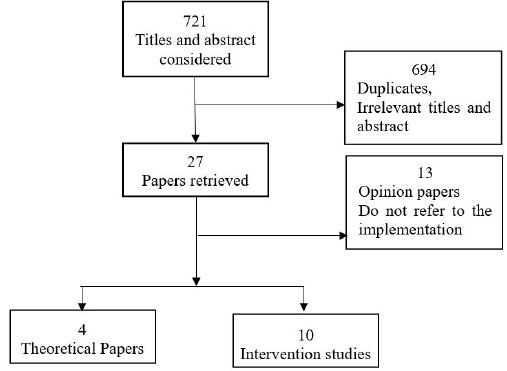
Results
Four theoretical papers that dealt with the implementation of the Health Promoting University concept
were found in the literature. The first document was developed by the University College Dublin (UCD)
as an implementation guide for Healthy Universities, namely in Ireland [25]. The UCD Health Promotion
Strategic Plan - ‘Healthy UCD’, aims to work in partnership with Higher Education Institutes to develop
a health promoting campus model of health promotion. As stated in the UCD Strategic Plan 2015-2020,
their mission is to “contribute to the flourishing of Dublin, Ireland, Europe and the world (…) providing a
supportive community in which every member of the University is enabled to achieve their full potential.”
Healthy UCD outlines an ambitious program for health promotion within the university community from
2015 to 2010 and beyond that will facilitate the delivery of the key objectives that form the basis of their
university strategic plan and direction for the next period. Successful implementation of Healthy UCD
will help create an organization that has faculty and staff who are engaged, committed and productive, and
students who graduate with a holistic education that places emphasis on health and wellbeing for themselves
and the global community they inhabit. As a health promoting university, UCD will be seen as a positive
and supportive environment in which to study and work, ensuring to attract and retain the brightest students
and most inspiring and creative faculty and staff. The proposed actions included: the creation of a culture
of health for the student formation; the development of healthy environments; and the implementation of
healthy policies. Although the importance of evaluation was mentioned, no guidance was provided on how
to carry out an evaluation of a Healthy University.
The second document aims to contribute to the debate on Health Promoting Universities and Colleges (HPUC) movement in Portugal and it not only presents arguments for health promotion in the national higher education setting and examples of health promotion initiatives carried out by Portuguese higher education institutions, but also challenges these institutions to take some measures that would accelerate the transformation advocated by the HPUC movement [26]. It defined a Health Promoting University as an institution that is committed to creating an environment and culture that encourages health and well-being of all its members’. Proposed actions included: the implementation of healthy policies; the creation of an organizational structure to coordinate all actions related to health, and the provision of a healthy physical environment. This paper recommended that the highest university authority should lead the strategy, and that there should be a coordinating team and a working group involving different members of the university community. The implementation and the evaluation were recognized as useful to improve and redesign the program, but details on how to evaluate a Health Promoting University were not given.
The third one was a glossary addressing key concepts associated with Healthy (or Health Promoting) Universities in Chile [27]. This glossary defined a Healthy University as ‘an institution that includes health promotion within their educational project to improve the health of their community members’. Actions that were proposed included: information and awareness-raising on health issues, online educational activities, institutional changes and improvement of the physical environment. The glossary highlighted the importance of developing healthy policies that integrate the concept of healthy lifestyle in the curriculum and institutional culture. Evaluation was recognized as an important but complicated process, the success of which depends on the physical-environmental context and available human resources.
The fourth document was developed by the Ministry of Health of Peru as an implementation guide for Healthy Universities [28]. It referred to a Healthy University as an institution that implements health policies, encourages learning for health, and promotes the participation of all those involved in the decision making process, and described it as also contributing to the eradication of poverty, hunger, maternal mortality, and other health challenges. The proposed actions included: the creation of a culture of health for the student formation; the development of healthy environments; and the implementation of healthy policies. Although the importance of implementation and evaluation was mentioned, no guidance was provided on how to carry out an evaluation of a Healthy University.
Ten intervention studies describing the implementation of the Health Promoting University concept were
identified in the literature. Two studies reported the findings of a national-level qualitative study, one study
carried out in England and the other carried out in Brazil, providing a summary of the activity developed
by various institutions [3,29]. The other eight studies described one intervention. The information extracted
from these studies is summarized below.
All studies proposed a definition of Healthy Universities or Health Promoting University, Faculty or School (see Table 1). Among the studies, a Healthy University was defined as an institution that: integrates health in its educational project; provides a supportive environment for health; protects health and promotes the well-being of all community members through healthy policies. Some studies added that a university is based on the values of respect, active citizenship and solidarity.
In all studies, establishing Healthy Universities entails several areas of action (see Table 2). Seven studies mentioned the development of personal skills and knowledge regarding health, the creation of healthy environments and the incorporation of health issues in the curriculum [12-16,20,30,31,32]. Six studies mentioned the development of healthy policies [2,12,13,20,29,33]; and five studies mentioned activities with the local community [2,12,20,29,32]. The continued provision of health services was named in two studies [20,29], and in other two studies the subject of healthy workplaces was also addressed [12,32]. In one study, research was also considered an area of action [2].
Regarding the issue subject matters - these constitute the health issues that are addressed in the context of a Healthy University. The prevention of alcohol and drug abuse was mentioned most often, in nine of the ten studies [2,12,13,16,29-33]; eight studies mentioned activities focused on healthy eating [2,16,20,29- 33], five studies mentioned activities focused on mental health [2,12,13,20,31], and sexual health and STD/ AIDS prevention [2, 12,16,20,30]. Physical activity was mentioned in four studies [2,20,31,32], and smoking cessation and promotion of smoke-free spaces [20,30-32]. Road safety and transportation were mentioned in three studies [2,12,33], and the prevention of chronic diseases in other three studies [30,31,33]. Other issues mentioned included building design [2,3], healthy sleep [16]; oral health [30], family-studies relationship [30] and academic performance [30].
Projects and coordination were also analyzed. In four studies, the faculties of medical sciences or related careers were responsible for leading the Healthy University program [12,13,16,31]. One study mentioned that the project was an initiative of the university’s authorities [33]. Another study indicated that the project was a collaboration between governmental agencies supported by WHO [20]. Other services in charge were the human resources/occupational health, academic department, student services and sports department [2,31,32]. The presence of a steering group was mentioned in seven studies [2,12,13,29,31-33], six of which had representatives from different members of the university community [2,12,20,29,32,33].
While the importance of evaluation was acknowledged in all studies, details on the type of evaluation performed were provided only in seven studies [2,16,20,30-33]. Most evaluations involved the use of questionnaires or interviews with students, teachers and/or workers [2,16,20,30-33]. Questionnaires were used either to measure modifications in knowledge and health-related behaviors, or to identify needs and opinions about different aspects of the project. Only two studies reported the results of the evaluation process [12,20], observing improvements in the well-being of members of the university community and in the physical and social environment. An increase in health-related knowledge and decrease in harmful behaviors among students were also reported in these studies.
Concerning the issue adaptation to the context - Six of the ten studies provided information regarding adaptation to the cultural context, having aimed to make the program more culturally sensitive [2,12,16,20,32,33]. Actions mentioned in this regard were the involvement of students and of academic and non-academic staff in the planning and implementation of the initiative. Four studies highlighted the participation of volunteer students in the implementation through peer education projects on issues such as sexual health and drug use [2,12,20,32], thus ensuring greater credibility and acceptability by the rest of the university community. The development of health education material tailored to problems that were specific of the university community was mentioned in four programs [12,16,20,32]. In three programs, information on the needs of those involved was collected through a diagnostic process in an effort to adapt the program to the cultural context [2,16,33].
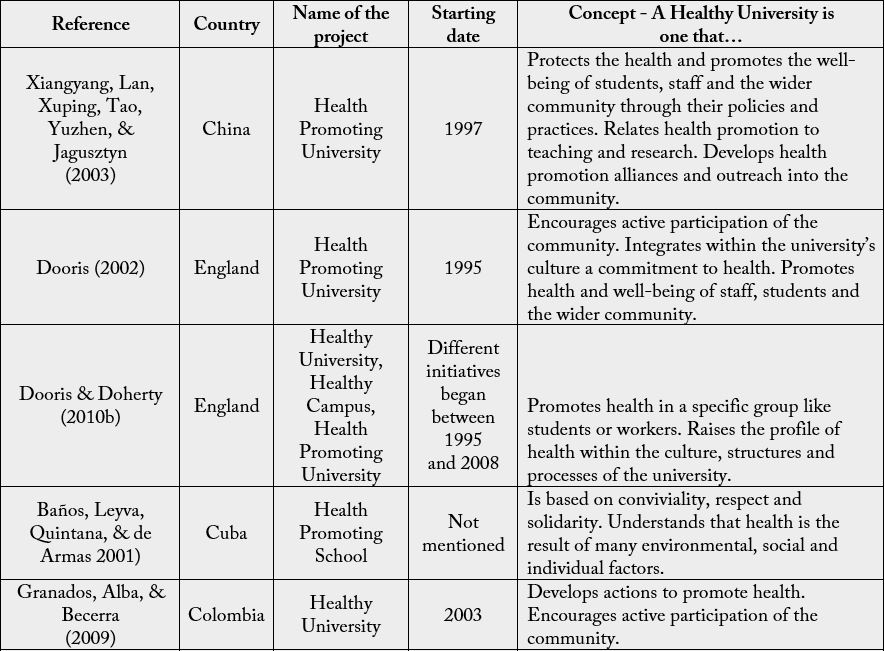
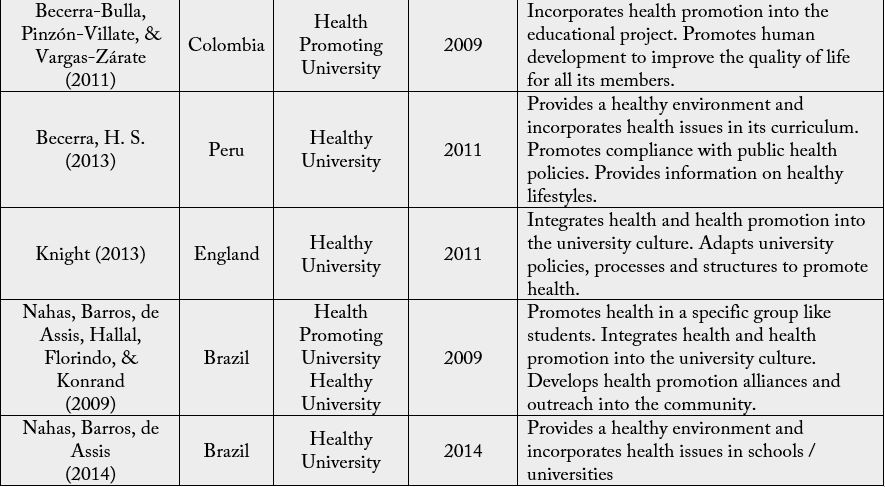
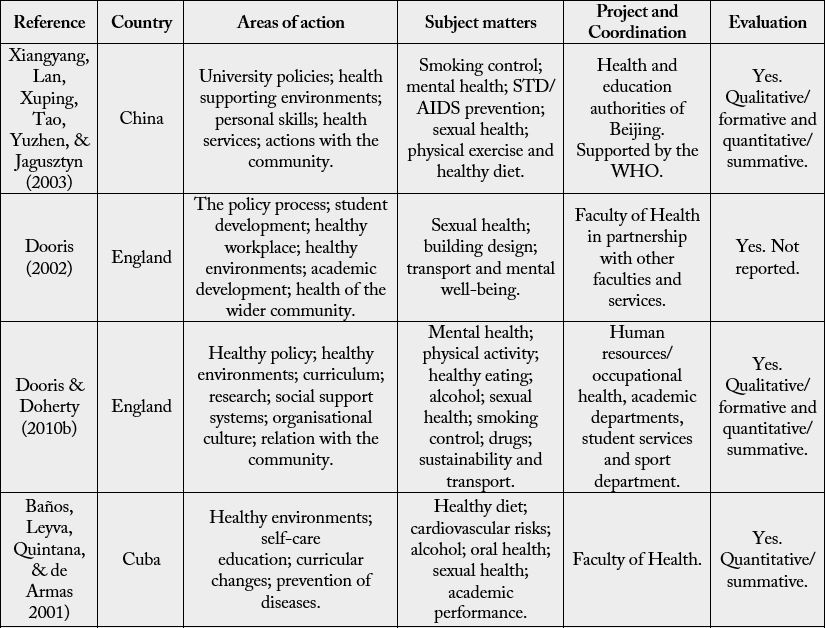
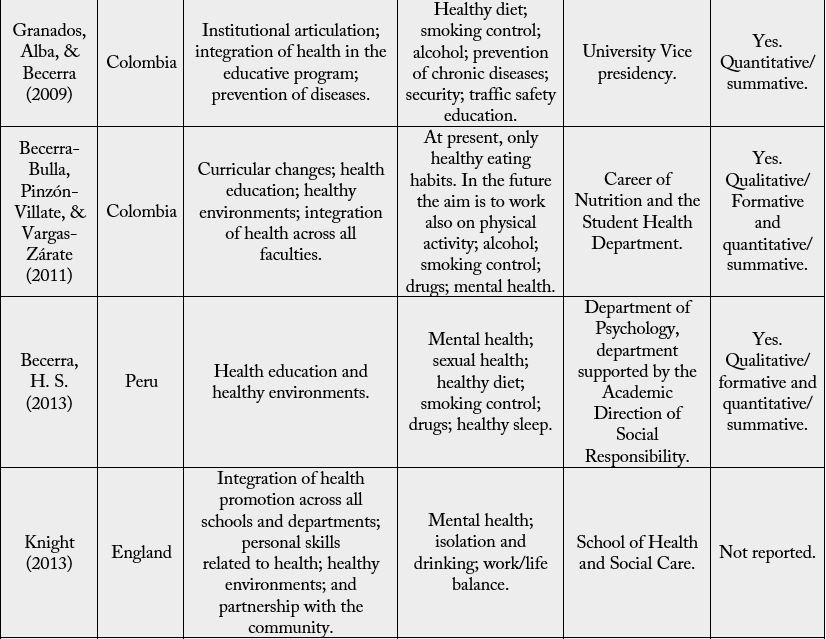
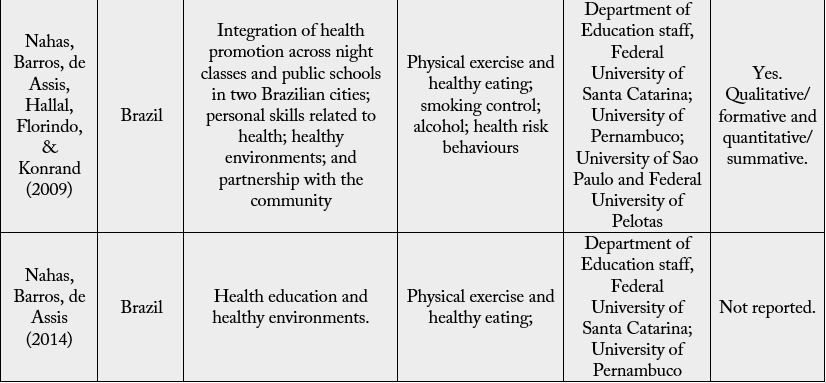
Discussion
This literature review confirmed that there is, among Portuguese HEIs, increasing interest in moving beyond
merely targeting health promotion interventions at students and staff to embrace the wider concept and
practice of Healthy Universities. Also, the literature review provides insight in the way in which the Health
Promoting University concept has been implemented by universities and adapted to cultural context. While
there is a vast literature on interventions aimed at university students that focus on a single health issue
[5,34], only a small number of studies could be found that describe the implementation of programs focusing
on the entire university community through a whole systems approach.
Overall, the Healthy University initiative was in different stages of development and implementation of a whole university approach, with only a few universities focusing on the university community in its totality and many acknowledging the challenges involved in achieving and embedding the wide-ranging cultural change necessary to translate vision into reality. Furthermore, they also suggested that there has been a relative scarcity of rigorous evaluation at this whole system level, with studies being limited to component projects and interventions. In part, this reflects the informal status and early stage of the development of Healthy Universities in Portugal. However, it is also symptomatic of the challenges involved in generating robust evidence of effectiveness for complex, multidisciplinary whole system programs [3,5].
The programs described in the studies included in the review are mostly based on the guidelines of the Edmonton Charter [11], and incorporate the main objectives and actions of the Health Promoting University proposed by Dooris [1-3].
The items of work that are addressed through the Health Promoting University initiatives are very similar across universities, showing that universities focus mainly on the most common health problems associated to young people. The programs included in the review were most often coordinated by faculties of medical sciences. This may be because those in health-related careers recognize it as their duty to support the health of the university community. The challenge for the health faculties is to convince the university authorities of the responsibility the university has regarding health promotion [17]. This is important, because the alignment of the top-down commitment of university authorities with bottom-up action is essential for a Health Promoting University program [12]. Nevertheless, actively involving members in the planning, implementation and evaluation of the program is important, as it allows the intervention to be adapted to the specific cultural context. Moreover, by equipping stakeholders with the know-how and tools to identify and implement the essential program components and coaching them in the implementation process, the members of the community can become empowered to take on future projects themselves while staying faithful to the Health Promoting University principles, as proposed in the empowerment implementation approach [23].
To evaluate the program, most studies assessed the modification of health-related knowledge and/or behaviors, typically using interviews and questionnaires. Effects at a more systemic level, such as the creation of a health-promoting environment or the integration of health within the university culture, are less often assessed. This may be due to the inherent difficulty of assessing initiatives using the healthy setting approach. However, it is important to remember that the objective of a Health Promoting University is to improve the health of its members and integrate health within the university culture. Both are long- term processes, the results of which cannot be observed immediately [3,10]. Further studies on the evaluation and effectiveness of Healthy University initiatives are needed, especially in Portugal.
To guide the work of universities that have made a commitment to health, the objectives of the Health Promoting University established in the strategic framework [3] provide a sound basis. Successful compliance with these objectives means that a university can be considered a Health Promoting University. In the initiatives presented in this review, compliance with certain objectives is better in some universities than others. Providing opportunities for a healthy environment and developing personal skills and knowledge regarding health are objectives for which most universities have made important efforts.
On the other hand, the implementation of healthy policies, incorporating health promotion in the curriculum development across all faculties, and developing links with the community remain challenging in three of the studies [16,30,31]. These initiatives, which have found it more difficult to comply with all the objectives, have in common that the interest to develop the Health Promoting University program came from a particular group in a faculty or department. It seems that in this scenario, fulfilling all objectives of a Health Promoting University is more challenging.
Conclusion
Higher education offers enormous potential to impact positively on the health and well-being of students,
staff and the wider community through education, research, knowledge exchange and institutional practice.
There is also a growing appreciation that investment for health within the sector will contribute to core
agendas such as staff and student recruitment, experience and retention; as well as institutional and societal
productivity and sustainability. Despite this, health and well-being remain largely marginal to the mission
and organization of higher education.
Despite the few studies found, this systematic review as revealed the rich diversity of health-related activity taking place within HEIs and points to a burgeoning interest in the whole system Healthy University approach.
The results show that the majority of these universities work towards similar goals, relying on the framework for Health Promoting Universities. However, for some of its objectives the implementation can be challenging, namely in Portugal.
Whereas the concept of the Health Promoting University was developed in a western European context, it is important to consider the factors that make this initiative successful in different contexts. The adaptation of the Health Promoting University concept to the specific characteristics of very different cultural contexts seems to be one of them. In the few published studies that explicitly describe the implementation of the Health Promoting University approach, only adaptations of superficial cultural aspects were identified. Adaptations that take into account deep cultural factors such as history, religion or social context may maximise the potential of the Health Promoting University initiative. Participation of members of the university community in the planning, implementation and evaluation process is also particularly valuable. More studies focusing on these context-dependent modifications would be more than welcome.
Finally, for these initiatives to continue developing, the political support of the authorities and the scientific and academic body is required. On the one hand, political support would need to incorporate the promotion of health in all areas and university services. On the other hand, the role of the academic and scientific community is to strengthen the exchange of results and experiences, to achieve the goal of identifying models of good practice [14].
Acknowledgements
To the Foundation for Science and Technology / Ministry of Science and Higher Education.
Bibliography

Hi!
We're here to answer your questions!
Send us a message via Whatsapp, and we'll reply the moment we're available!